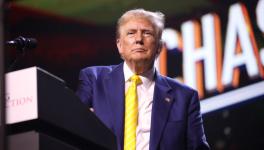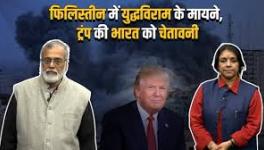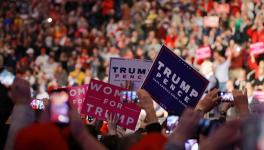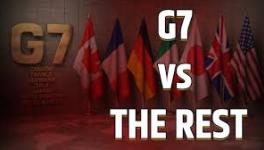Russia, China Won’t Accept US Nuclear Superiority
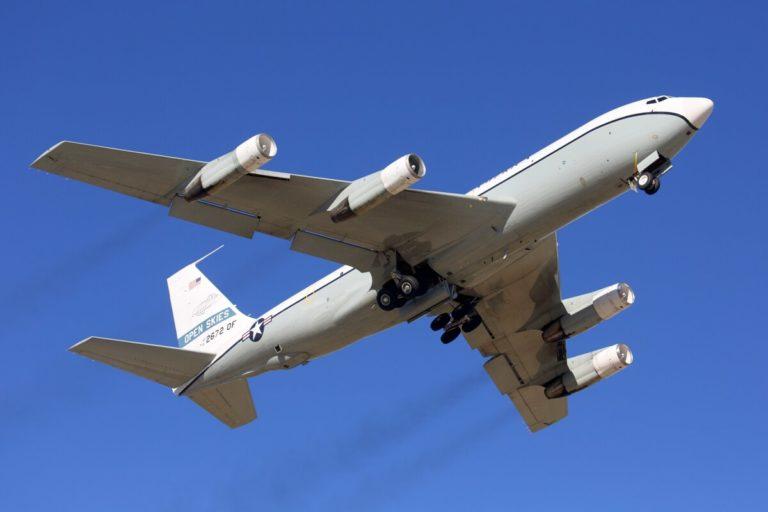
An American OC-135B takes off at Kubinka air base in Russia to conduct aerial surveillance of Russian military assets under the Open Skies Treaty.
Geopolitics has returned with a bang although Covid-19 is still very much around and a ‘second wave’ is also expected. The US President Donald Trump’s arms control negotiator, Special Presidential Envoy Marshall Billingslea said in an online presentation to a Washington think tank on Thursday that the United States is prepared to spend Russia and China “into oblivion” in order to win a new nuclear arms race.
As he put it, “The president has made clear that we have a tried and true practice here. We know how to win these races and we know how to spend the adversary into oblivion. If we have to, we will, but we sure would like to avoid it.”
We are back to the era of the Manhattan Project. The US is rebooting its 75-year old moribund chase of nuclear superiority over its adversaries. Its corollary also appeared on Thursday when the Trump administration announced that it will withdraw from the Open Skies Treaty of 1992 (which was first proposed by US President Dwight Eisenhower in 1955 and was ultimately pushed forward by President George H.W. Bush as a way of promoting stability in Europe after the Cold War ended.)
The Open Skies Treaty came into effect in 2002 with some 34 countries joining it, including Russia of course, which permits each party state to conduct unarmed reconnaissance flights over the others’ entire territories to collect data on military forces and activities under clearly defined rules of conduct as regards the type of monitoring equipment to be used, the procedures and so on.
The reconnaissance / surveillance flights could often be at short-notice so that the spying missions could be mounted faster than a satellite can be moved into position. Equally, the aircraft used are highly specialised and would have on-board observers of the states spied upon. The treaty retained many benefits for all sides and has a wider context insofar as it was a unique confidence-building measure that doubled up as critical underpinning to arms control agreements.
Washington is resorting to the by-now-familiar plea that it is withdrawing from the treaty due to repeated Russian violations of its terms, an argument the Trump administration had advanced last year also while scuttling the INF Treaty of 1987, which banned all of the US and Russia’s land-based ballistic missiles, cruise missiles, and missile launchers with ranges of 500–1,000 kilometers (short medium-range) and 1,000–5,500 km (intermediate-range).
The US will formally withdraw from the Open Skies accord in six months, American officials have said. The news was confirmed by Trump himself midday, followed by a special briefing by the US State Department, kicking off a six-month clock before a formal exit occurs. The move was not a surprise, as Washington had signalled to its European allies toward the end of last year that the US would consider withdrawing.
The Russian Foreign Ministry has reacted that it had not violated the treaty and that a US withdrawal would be “very regrettable”, adding that the Trump administration was working to “derail all agreements on arms control”. The statement said,
“This decision is a deplorable development for European security. This US-initiated treaty is a major component of European security… US security concerns will not improve either and its international prestige is bound to be hurt. The policy to discard the Open Skies Treaty calls into question Washington’s negotiability and consistency. This is a source of serious concern even for US allies. Russia’s policy on the treaty will be based on its national security interests and in close cooperation with its allies and partners.”
Indeed, this is not the first arms control agreement that the Trump administration has abandoned. What we are witnessing is the Trump administration dismantling systematically the entire fabric of arms control inherited from the Cold War era. The keystone of arms control, the New Strategic Arms Reduction Treaty or START agreement, expires in 2021, and there is little enthusiasm in the US for its extension.
The US’ dreams of attaining nuclear superiority over the former Soviet Union proved a chimera. The Trump administration’s enterprise can only meet a similar fate. In the Russian defence doctrine, global stability is riveted on strategic balance and there is no question of Moscow conceding nuclear superiority to the US, no matter what it takes.
A new dimension has no appeared in the pointed reference in the Russian statement to Moscow formulating its policy apropos the US decision on the Open Skies Treaty “in close cooperation with its allies and partners”. It hints at a Russian policy response in coordination with China. If so, the Russian-Chinese entente is being elevated to a qualitatively new level. It may be recalled that on the sidelines of an international affairs conference in Moscow last year, President Vladimir Putin had revealed that Russia is helping China build a system to warn of ballistic missile launches.
Putin added that “this is a very serious thing that will radically enhance China’s defence capability”. The seemingly inadvertent remark was calibrated to signal a new degree of defence cooperation between Russia and China at a juncture when Washington branded both as revisionist powers that challenged US interests globally and must be countered.
The period since October is characterised by growing belligerence in the US force projection toward Russia and China. The Chief of Staff of Russia’s North-Eastern Joint Command Mikhail Bilichenko said in December that US was boosting its activity near the Chukotka Peninsula, “increasing the grouping and practicing, among other things, the landing of an amphibious assault force.”
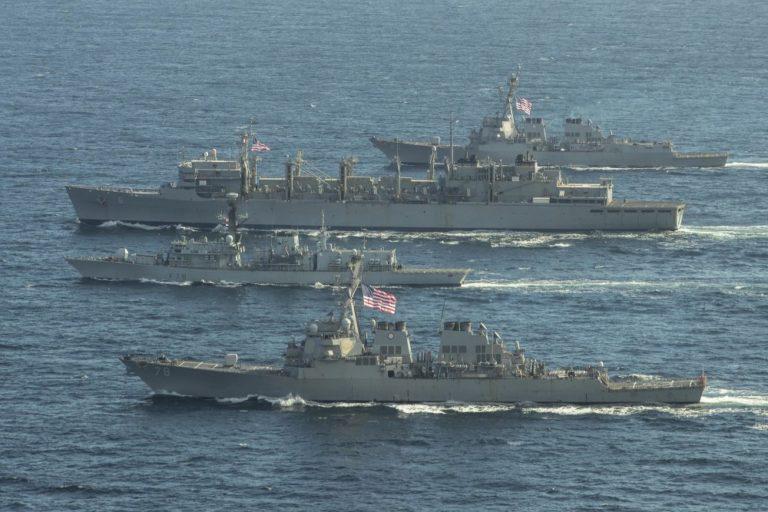
US Navy ships USS Porter, USS Roosevelt, USS Supply (6) in Barents Sea.
Earlier this month, a US Navy strike force of the 6th Fleet began operating in the Barents Sea, north of Russia, for the first time since the Cold War, further expanding its portfolio of Arctic operations by aircraft carriers and surface combatants in the past two years. Three Arleigh Burke-class Aegis destroyers – USS Donald Cook, USS Porter and USS Roosevelt along with fast combat support ship USNS Supply (T-AOE-6) are in the Barents Sea to “assert freedom of navigation and demonstrate seamless integration among allies,” according to a U.S. Navy news release.
Similarly, a longer-term struggle between the US and China is at a turning point, as the former rolls out new weapons and strategy in a bid to close a wide missile gap with China. Having got rid of the constraints under the INF Treaty, the Trump administration is planning to deploy long-range, ground-launched cruise missiles in the Asia-Pacific region. according to the White House budget requests for 2021 and Congressional testimony in March of senior U.S. military commanders, the Pentagon intends to arm its Marines with versions of the Tomahawk cruise missile now carried on US warships, It is also accelerating deliveries of its first new long-range anti-ship missiles in decades.
And, in a radical shift in tactics, the U.S. moves are aimed at countering China’s overwhelming advantage in land-based cruise and ballistic missiles. The US Navy maintains a powerful presence off the Chinese coast. The guided-missile destroyer USS Barry passed through the Taiwan Strait twice in April. And the amphibious assault ship USS America last month exercised in the East China Sea and South China Sea. A Reuters Special Report this month quoted a former senior Australian government defense official as estimating, “The Americans are coming back strongly. By 2024 or 2025 there is a serious risk for the PLA that their military developments will be obsolete.”
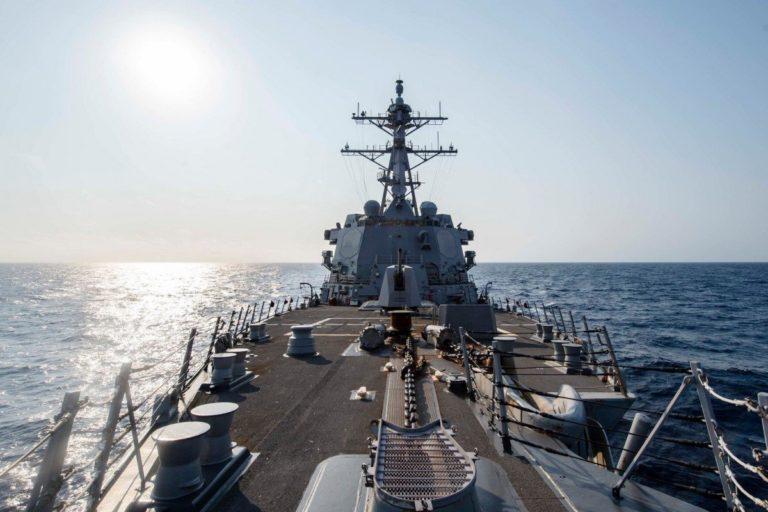
The guided-missile destroyer USS McCampbell made a transit through the Taiwan Strait, May 14, 2020
Beijing has been repeatedly warning that it will not stand by idly if the provocative US force projections continued. In an article last week in the Chinese Communist Party tabloid Global Times, the daily’s editor-in-chief Hu Xijin wrote that China should increase its nuclear warheads to 1,000 “in a relatively short time span”, and to procure at least 100 DF-41 strategic missiles, the country’s fourth-generation and latest solid-fuelled road-mobile intercontinental ballistic missile with an operation range upto 15000 kilometres.
Hu, a hugely influential opinion maker, argued that it is no more sufficient for China to develop adequate nuclear deterrent, since the US government has identified China as its largest strategic competitor, and Washington is “more likely to exert all its power at its disposal to suppress and intimidate China… it is highly likely that it could even take similar risks that led to the Cuban missile crisis.” Therefore, China needs to possess such power that prevents the US politicians from “gambling with its nuclear armament and harming China.”
In plain terms, Hu said, if the US tries to subdue China in the Taiwan Straits or the South China Sea, which are its core interests, to considers that defeating China is necessary for perpetuation of its global hegemony, then “China must fix its nuclear gap with the US.” At a time when Washington sharply increases its investment in nuclear arsenal armament as the “cornerstone of American politics and psychology,” China needs a bigger depot of nuclear weapons.
The post-Covid era is destined to see an acceleration of strategic competition between the big powers. The existing strategic conventions are being jettisoned and new weapons systems are being developed, such as very high-speed, hypersonic missiles. Also undermining deterrence is Artificial Intelligence. To tamp down the intensifying geopolitical contestations, a bolstering of the old arms control order would have helped but the opposite is happening.
Get the latest reports & analysis with people's perspective on Protests, movements & deep analytical videos, discussions of the current affairs in your Telegram app. Subscribe to NewsClick's Telegram channel & get Real-Time updates on stories, as they get published on our website.












